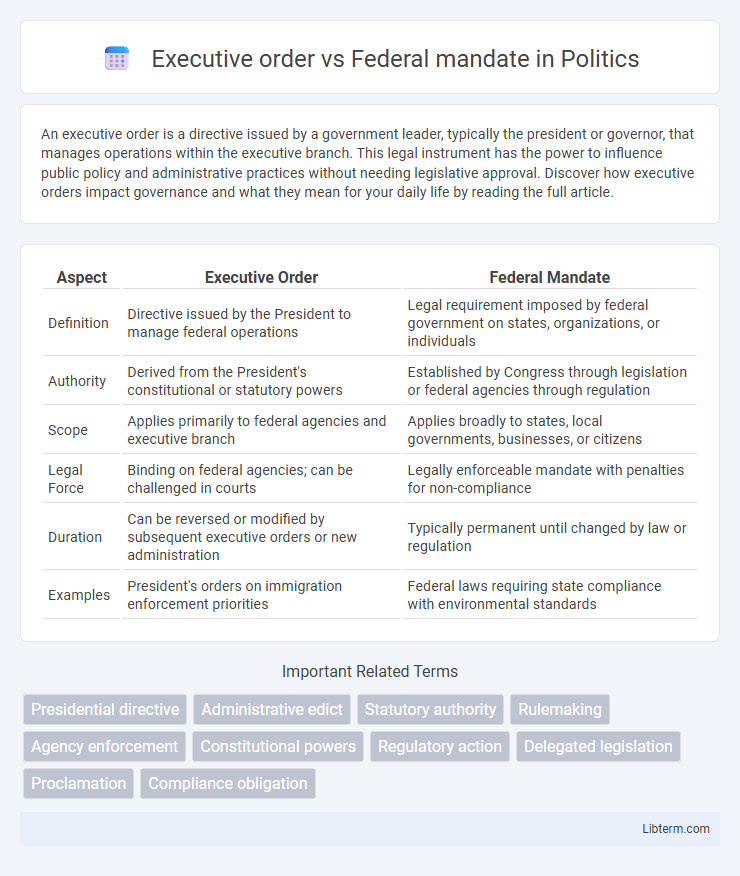An executive order is a directive issued by a government leader, typically the president or governor, that manages operations within the executive branch. This legal instrument has the power to influence public policy and administrative practices without needing legislative approval. Discover how executive orders impact governance and what they mean for your daily life by reading the full article.
Table of Comparison
| Aspect | Executive Order | Federal Mandate |
|---|---|---|
| Definition | Directive issued by the President to manage federal operations | Legal requirement imposed by federal government on states, organizations, or individuals |
| Authority | Derived from the President's constitutional or statutory powers | Established by Congress through legislation or federal agencies through regulation |
| Scope | Applies primarily to federal agencies and executive branch | Applies broadly to states, local governments, businesses, or citizens |
| Legal Force | Binding on federal agencies; can be challenged in courts | Legally enforceable mandate with penalties for non-compliance |
| Duration | Can be reversed or modified by subsequent executive orders or new administration | Typically permanent until changed by law or regulation |
| Examples | President's orders on immigration enforcement priorities | Federal laws requiring state compliance with environmental standards |
Understanding Executive Orders: Definition and Purpose
Executive orders are official directives issued by the President to manage federal government operations and enforce existing laws. They have the force of law within the executive branch but cannot create new laws without Congressional approval. These orders serve to clarify policies, direct agencies, and address urgent issues without the need for lengthy legislation.
What is a Federal Mandate? Key Features
A Federal Mandate is a directive issued by the federal government requiring state or local governments to comply with specific rules or regulations, often tied to federal funding. Key features include compulsory compliance by subordinate governments, potential penalties for noncompliance, and a focus on addressing nationwide policy goals such as environmental standards, healthcare, or education. Unlike executive orders, federal mandates often involve legislative backing and enforceable requirements linked to federal assistance programs.
Legal Authority: Executive Order vs Federal Mandate
Executive orders derive their legal authority from the President's constitutional powers as the head of the executive branch, allowing direct management of federal operations without requiring congressional approval. Federal mandates, however, are legally binding requirements imposed by Congress through legislation, compelling state or local governments and private entities to comply. While executive orders can be overturned by legislation or court rulings, federal mandates carry the force of law enacted by Congress and are enforceable unless declared unconstitutional.
Scope and Application Differences
Executive orders are directives issued by the President to manage operations of the federal government and primarily apply to federal agencies and officials. Federal mandates, often enacted by Congress, require state or local governments and sometimes private entities to comply with specific regulations or standards, frequently involving broader public impact. The scope of executive orders is generally limited to executive branch functions, while federal mandates can impose obligations on multiple levels of government and the public sector.
How Are Executive Orders Enforced?
Executive orders are enforced through the executive branch agencies responsible for their implementation, backed by the authority of the President as the head of the executive branch. Federal agencies issue regulations and directives to ensure compliance with the executive order's provisions, and failure to comply can lead to administrative actions or legal challenges. Courts may also play a role by reviewing the legality of executive orders when their enforcement is contested.
The Process Behind Issuing Federal Mandates
The process behind issuing federal mandates involves legislative authority empowering federal agencies or the executive branch to impose compliance requirements on state or local governments and private entities. Federal mandates often originate through statutes passed by Congress, which then delegate regulatory authority to federal agencies that develop detailed rules and guidelines. Unlike executive orders, which the president can issue unilaterally within the scope of executive authority, federal mandates require legal backing through congressional legislation or judicial rulings, ensuring a formal rulemaking process with public input and oversight.
Historical Examples: Executive Orders in Action
Executive orders have been pivotal in shaping U.S. policy, as demonstrated by President Franklin D. Roosevelt's Executive Order 9066, which authorized Japanese American internment during World War II, highlighting the executive branch's power in times of crisis. Another notable example is President Harry S. Truman's Executive Order 9981, which desegregated the armed forces in 1948, reflecting the role of executive orders in advancing civil rights. These historical cases showcase how executive orders can implement significant federal actions without requiring congressional approval, distinguishing them from federal mandates that often result from legislation.
Notable Federal Mandates and Their Impact
Federal mandates such as the Clean Air Act and the Americans with Disabilities Act have profoundly shaped environmental standards and workplace accessibility nationwide. Executive orders, while influential, typically direct government operations without the broad legislative enforcement power of federal mandates. The implementation of notable mandates has led to substantial public health improvements and societal equity advancements across the United States.
Limitations and Challenges of Both Mechanisms
Executive orders face limitations such as vulnerability to judicial review and potential reversal by subsequent administrations, which can undermine long-term policy stability. Federal mandates often encounter challenges related to states' resistance due to perceived federal overreach and the financial burden imposed without adequate funding. Both mechanisms struggle with implementation consistency, political backlash, and balancing federal authority with state autonomy.
Executive Orders vs Federal Mandates: Key Takeaways
Executive orders are directives issued by the President to manage federal government operations, whereas federal mandates require states or local governments to comply with specific federal regulations, often backed by legal authority and penalties. Executive orders can be swiftly implemented but are limited to the executive branch, while federal mandates are broader in scope, impacting multiple government levels and often stemming from legislation. Understanding the distinction is crucial for evaluating federal power, policy enforcement, and institutional responsibilities.
Executive order Infographic

 libterm.com
libterm.com